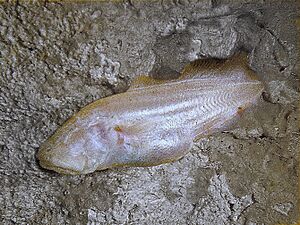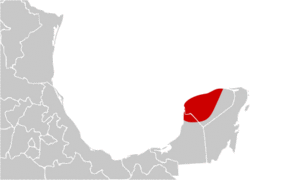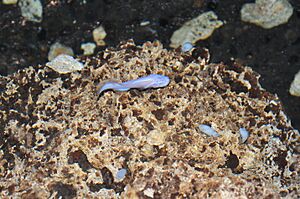Mexican blind brotula facts for kids
Quick facts for kids Mexican blind brotula |
|
|---|---|
 |
|
| Conservation status | |
| Scientific classification | |
 |
|
| Synonyms | |
|
The Mexican blind brotula (Typhliasina pearsei) is a special type of fish. It lives only in Mexico, mainly in sinkholes and caves. People in Mexico call it sak kay in Mayan and dama blanca ciega in Spanish. This fish is a cavefish, meaning it lives its whole life in dark caves. It can grow up to about 9.7 centimeters (3.8 inches) long. It is the only known species in its group of fish.
Contents
What it Looks Like
The Mexican blind brotula has a big head that is flat on the sides. It does not have any scales on its head. This fish also has no eyes, which is common for animals living in dark caves. Instead of eyes, it has special bumps and hollows on its head. These spots are full of sensory organs that help it feel its way around.
Its nostrils are on its upper lip. The mouth has a long split at the back. The rest of its body has scales. It has long fins on its back and belly that reach almost to its tail fin. The fin on its back has no sharp spines, only soft rays. The fin on its belly also has no spines.
Male brotulas have two pairs of special parts called pseudoclaspers. The fish's skin has no color, so it looks pinkish-white. This is because it lives in darkness and does not need to blend in with its surroundings.
Where it Lives
The Mexican blind brotula lives in the Yucatán Peninsula in Mexico. It makes its home in cenotes, which are water-filled sinkholes. It also lives in underground water systems called aquifers. The water in these places stays warm all year, usually between 23 and 27 degrees Celsius (73 and 81 degrees Fahrenheit).
These water systems are often connected to the sea. However, the Mexican blind brotula only lives in parts of these systems that have fresh or slightly salty water.
Life and Habits
The Mexican blind brotula is a top hunter in the Yucatán aquifer system. This means it is at the top of the food chain there. It probably does not have a very large population. It eats small creatures like shrimps and other crustaceans that also live in the underground waters.
Sometimes, you can find this fish living near another blind fish called the blind swamp eel. In one cave system, it even lives with a type of catfish. The Mexican blind brotula cannot see light, but it is very good at sensing vibrations in the water. This helps it find food and avoid danger in the dark.
Reproduction
The Mexican blind brotula is a viviparous fish. This means that the mother gives birth to live young, instead of laying eggs. She can have up to a dozen babies at a time. The young are usually born between December and February. When they are born, they are yellowish in color. They are about 2.4 to 3.7 centimeters (0.9 to 1.5 inches) long.
Conservation Status
The biggest danger to the Mexican blind brotula is water pollution. The underground water systems where it lives are often below towns and cities. Sometimes, dirty water from these places can leak into the aquifers. This can bring harmful bacteria and too many nitrates into the water.
Because of these threats, the International Union for Conservation of Nature has listed this fish as "near threatened." This means it could become endangered if its habitat is not protected.
About its Name
The first part of its scientific name, Typhliasina, comes from the Greek word typhlos. This word means "blind." The second part of its name, pearsei, honors an American scientist named Arthur Sperry Pearse. He was an ecologist who collected the first example of this fish. This example was then used by Carl Leavitt Hubbs to officially describe the species.



